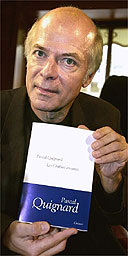

 字體:小 中 大
字體:小 中 大 |
|
|
|
| 2011/08/14 22:00:24瀏覽1755|回應0|推薦0 | |
在世界的每一個早晨 (日出時讓悲傷終結) Tous les matins du monde 2004.4.24 by Marcel “Tous les mantis du monde” – “在世界的每一個早晨”,是一部美麗的作品,也是一部成功的作品。它結合了深刻的人文理念、細緻的藝術表現與嚴謹簡樸的敘事風格,令我們在形式上的感動之中,更激起諸多有關藝術概念上的思維。本片1991年首映於法國,吸引了超過兩百萬人次的觀賞,其後1992年於美國及世界三十餘國發行,而電影原聲帶發行量更超過50萬張。  本片的故事情節,簡單而直接。以十七世紀古大提琴 (viol da gamba) 大師既作曲家Marin Marais (1656-1728) 的第一人稱,作為回顧的主軸。在感傷的回憶呢喃之中,訴說他如何追隨老師Sainte-Colombe (1640?-1700?) 學藝,以及如何受到老師藝術理念的感動。故事結構雖然單純,但經由Marais悔恨的語調,我們依稀接可以體會到Sainte-Colombe如何地提倡藝術目的純粹化,也同時沾染了Marais的覺悟。當然,除了中心的思考之外,音樂與畫面更是本片成功的主因。在優美感傷的琴聲之中,精心營造的光影與背景,無法不令我們立即想到一幅幅荷蘭畫派的作品 (有人認為最像Georges La Tour)。  本片之原著劇本與對白,出自法國當代大文豪Pascal Quignard之手。此公剛於2002年以“漂泊的陰影” (Les Ombre Errantes) 一書,榮獲象徵法國最高文學地位之龔固爾獎。全片不僅對白優美而發人深省,其背後的人文與藝術觀點,遠超過本片表層之形式所能傳達者。事實上,Quignard於2001年本片首映十年之後的短文 “Dix ans Apres” 中說道,關於Sainte-Colombe與Marin Marais的故事,他是在四部作品當中,分別以不同的時空與形式,闡述這段 ‘老師/學徒’、‘故鄉/放逐’、‘死亡/回歸’ 的概念。   四部中的首部是於1986年出版的 “Le Salon du Wurtemberg”,敘述一位大提琴手於1970年代從軍旅回鄉,在比利時的溫特堡所訴說的故事。第二部是於1986年出版的 “Le Lecon de musique”,書中比擬Marin Marais的第一人稱敘述者,闡述對音樂與藝術的理念。在其中他特別提到,古大提琴召喚的是 ‘亙古不變的聲音、始自孩提時代便失去的本質’,因此古大提琴那哀沉音色陳述的就是 ‘放逐’。“Tous les mantis du monde” – 本片之原著出處,於四年之後的1990年付印,藉由的Sainte-Colombe對亡妻無止境的懷念,暗示對音樂本質的執著。並以其弟子Marin Marais對恩師及其女兒Madeleine (與Marais相戀並幫忙教導Marais拉琴)的歉疚,襯托/比喻Marais念念不忘回歸藝術的純粹本質。 最後一部作品是於2000年出版之“Terrasse a Rome” (羅馬露台),以「小說-筆記-傳記」之文體,經由原籍洛林的巴黎銅版畫師傅 Meaum (1617-1667) 在地中海沿岸的飄泊,與其對愛人、恩師的思念,加之與未謀面的親生兒子之邂逅,對照已遭毀容的他終生想要將自然、純粹與藝術結合的渴望。除了這四部作品之外,Quignard並準備再寫一本書,敘述Sainte-Colombe晚年自英格蘭回國之後的故事,而且他打算以 ‘一切只是哀傷、渴望、憤怒、傲慢與傷痛’ 作為終結的尾句。   本片的音樂,除了有Sainte-Colombe與Marin Marais師徒的作品,並有十七世紀法國大師Francois Couperin及Jean-Baptiste Lully的大作。Lully華麗的進行曲 ‘Marche pour la ceremonie de Tures’,代表著Sainte-Colombe最痛恨的俗世與矯情 (對熟知此點的Marais而言,不啻是精神上的鞭笞)。Couperin的聖詠 ‘Troiseme Leccon de Tenebres’ (Third lesson of darkness),不斷地重覆要求著主的懲罰,似乎是Marais回憶中無盡的自責。最委婉動人的一首,是Marais為Colombe女兒Madeleine所寫的 ‘La Reveuse’ (夢中的女子),簡潔純情,象徵他對藝術永遠的追求。然而最感人的一首,莫過於Sainte-Colombe寫的 ‘Les Pleurs’ (淚水),在其中師徒二人因著對音樂的熱愛與回歸一同含淚合奏。衰弱垂死的Marais,在這賺人熱淚的畫面裏從過去中醒來,看見恩師站在陽光的來處向他微笑,使它想起恩師曾說音樂最高的目標,是要喚醒死者‧‧‧(是那永存於老師心中的師母、在Marais心中的Madeleine,還是藝術上逝去不回的純真?) Sainte-Colombe Les Pleurs’ (淚水) 學生 Marin Marais: Tombeau de M. de Ste-Colombe 另外值得一提的是,Sainte-Colombe所信奉的天主教派,是十七世紀中葉發展出的Jansenism。此派主張近於喀爾文新教派,與耶穌會相反,講求命定、形上思考與嚴格之紀律。因此,Sainte-Colombe對Marais與世俗風格的反應,多少與其信仰有關。而若要挑剔本片的缺點,或許就是那些提琴演奏的場景中,演員的指法往往與旋律有著極大的出入吧! 作為本文的結尾,並向Pascal Quignard與Sainte-Colombe致以最崇高的敬意,下文是Quignard在“Tous les mantis du monde” 開頭的段落: Monsieur de Sainte Colombe wrote down his new compositions in a leather-bound notebook. He did not want to publish them to the judgement of the public. He said that they were improvisations noted at the moment and for which the moment alone provided an excuse, and not completed works. On days when the spirit took him and when he could make time for leisure, he would go off to his brook and dream. In summer, when it was very hot, he took off his shoes and his shirt and gently went into the cool water, wading up to his neck, stopping up his fingers and burying his face in the water. One day when he was gazing at the ripples on the water, sighing, he dreamt that he was going into dark water and staying there. He had given up everything that he loved on earth, instruments, flowers, pastries, rolled scores, kites, faces, pewter plates, wines. Emerging from his dream, he remembered the Tombeau de Regrets that he had composed when his wife had left him one night to join the death, and he suddenly felt very thirsty. He got up, climbed up the bank grabbing hold of some branches and went off to his garden shed where he practiced his viol, hoping that he was out of earshot, so that he could try all possible hand positions and bowing movements without attracting anyone's judgment for this was just what he wanted to do. He put his bottle of wine wrapped in raffia on the light blue cloth covering the table where he unfolded his music stand, with the glass of wine that he had filled at his feet and a pewter plate containing some rolled honeycomb cakes, and he played the Tombeau des Regrets. He did not need to refer to his book. His hand found its own way over his instrument's fingerboard and he began to cry. As the melody rose, near the door a very pale woman appeared, smiling at him and indicating by her finger that she would not speak, so that he would not be disturbed in what he was doing. She walked silently around the music stand of Monsieur de Sainte Colombe. She sat down on the trunk of music which was in the corner near the table and the bottle of wine and she listened. It was his wife and his tears flowed (...)
|
|
| ( 不分類|不分類 ) |








